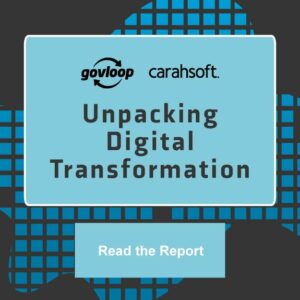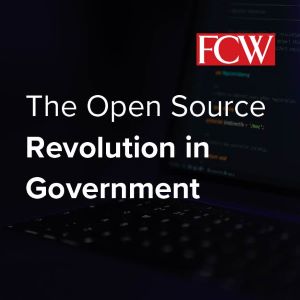At long last, Government agencies are getting some real support for their modernization and transformation initiatives. Through the Technology Modernization Fund (TMF) and the American Rescue Plan (ARP), Congress is providing significant funding for updating or replacing legacy systems, with a focus on both improving the security of government systems and delivering better services. The opportunity, now, is to make those investments pay off. How can agencies cut delivery times and meet expected outcomes? Download the guide to access worksheets, step-by-step guidelines, government and industry insights, and other resources that can help agencies launch transformation initiatives—and deliver on them.
Supercharge Your Agency Service Management
“Using cloud solutions, organizations can automatically scale up their systems when constituent demand is high and down when demand is lighter. This enables agencies to be more responsive, efficient and constituent-friendly. Most federal agencies are going through a major digital modernization effort, replacing outdated/ legacy systems with cloud-based solutions, said Sandra Trumbull with Atlassian, a software-based company. And self-service — whether through guided prompts, artificial intelligence or other methods — is increasingly important because users are more empowered and typically obtain faster responses service teams have fewer headaches, agencies can lower their service costs, and everyone receives a better overall experience.”
Read more insights from Adaptavist’s Phill Fox, Principal Customer Success Advocate, and Atlassian’s Sandra Trumbull, Enterprise Solutions Advocate.
 How Agencies Are Driving Innovation to the Edge
How Agencies Are Driving Innovation to the Edge
“Not so long ago, Air Force communications meant radios that transmitted information about where to go and what was happening. Now, digital input is being delivered directly into the cockpit. ‘We’re talking about a situation where edge capability expands the envelope of the missions that we can get accomplished and changes the ways in which we can accomplish them,’ said Winston Beauchamp, Deputy Chief Information Officer for the Department of the Air Force. Currently, the service uses edge computing in its Agile Combat Employment, a scheme of maneuvers aimed at increasing survivability while generating combat power. If warfighters are under threat at fixed bases, they must move to alternate locations quickly — and those might not have all the infrastructure of a traditional base. ‘Edge technologies enable you to deploy to that location that you need to accomplish that mission without a huge footprint,’ Beauchamp said.”
Read more insights from Red Hat’s Government Symposium.
Data, Data Everywhere, but Not a Byte to Eat
“The first element of intelligent data management is visibility: Where is agency data located? And directly associated, Breakiron said, is accessibility, knowing how the agency organizes and uses its information, and what the data’s condition is. ‘We often find, especially in the government, in excess of 50% of the data hasn’t been touched for as much as five years,’ he explained. ‘And we also find that about 20% of the data, you couldn’t talk to if you had to.’ Commvault calls that “orphan data,” and it’s akin to having a VHS tape but no VHS player with which to view it. An intelligent data management system creates a tiered storage approach that identifies long-ignored information, allowing an archival model for ‘pennies to the dollar vs. thousands of dollars in storage costs,’ he said.”
Read more insights from Commvault’s Richard Breakiron, Senior Director for Strategic Initiatives for the Federal Sector.
Build a Functional Ecosystem Through Cloud Architecture
“While technology is at the core of a total agency transformation, Chang advised against having it ‘dragging process and then dragging people along.’ The process and the people need to move along with the technology instead of clinging to its shirttails. ‘One thing I would offer as a piece of advice, having done multiple transformations in the Federal Government, is invest in upskilling your people,’ said Chang. ‘If your people can’t use the technology — no matter how great the technology is — the organization as a whole does not move forward.’ For federal environments, he urged technology upskilling to improve employees’ data literacy, analytics awareness and coding abilities — or at least to provide a basic familiarity with those activities.”
Read more insights from Snowflake’s Winston Chang, Chief Technology Officer for the Global Public Sector.
How Open Source Database Technology Can Support Transformation
“Modernizing your applications and services without modernizing the underlying database is like buying a new car but installing your old engine. You’re just holding yourself back. That’s the experience of Enterprise DB (EDB), which provides tools and services to large organizations adopting PostgreSQL (Postgres), a relational database management system based on open source technology. Like other enterprise-grade, open source systems, Postgres helps organizations avoid the rising licensing costs and vendor lock-in that come with proprietary software, said Jeremy Wilson of EDB. But just as importantly, Postgres is rapidly replacing legacy, proprietary software as a platform for innovation.”
Read more insights from EDB’s Jeremy Wilson, CTO of North America Public Sector.
Transforming With Visibility and Agility
“Staff working their way through a digital transformation, such as a cloud migration, will need new skillsets. They’re going to use new services and capabilities — and none of them will be the same, Shopp said. SolarWinds helps users build knowledge, intelligence, configuration smarts and cloud awareness, he explained. ‘Intelligence in a box,’ as Shopp called it, is codified into SolarWinds products and helps agency employees monitor workloads. ‘When it comes to understanding your infrastructure and your workloads, no matter where they reside — on premises, the cloud or hybrid — we’ve got you covered,’ Shopp said.”
Read more insights from SolarWinds’ Brandon Shopp, Group Vice President of Product.
Observability Made Simple
“The task of monitoring these complex systems gets more complicated, too. ‘The question is, how do I know there’s an issue?’ said Brian Mikkelsen of Datadog. ‘Is it when the tickets start flowing, when complaints increase, when your leadership team asks why something isn’t working?’ None of those options is ideal. Datadog’s application performance management platform provides a real-time window into the digital environment, identifying performance and security issues — quickly. Its ‘full stack’ hybrid infrastructure capability means everything from the back end to the front end is monitored and reported via infrastructure metrics, application performance traces, and correlated logs.”
Read more insights from DataDog’s Brian Mikkelsen, Vice President and General Manager.
Download the full GovLoop Guide for more insights from these digital transformation leaders and additional government interviews, historical perspectives and industry research.

 “Open source transforms the way agencies manage hybrid and multi-cloud environments. The most critical technology in the cloud, across all providers, is Linux. Everything is built on top of that foundation — both the infrastructure of the cloud and cloud offerings. Given the right partner, the promise of Linux is that it provides a consistent technology layer for agencies across all footprints, including multiple cloud providers, on-premises data centers and edge environments. From that foundation, agencies and their partners can build portable architectures that leverage other open source technologies. Portability gives organizations the ability to use the same architectures, underlying technologies, monitoring and security solutions, and human skills to manage mission-critical capabilities across all footprints.”
“Open source transforms the way agencies manage hybrid and multi-cloud environments. The most critical technology in the cloud, across all providers, is Linux. Everything is built on top of that foundation — both the infrastructure of the cloud and cloud offerings. Given the right partner, the promise of Linux is that it provides a consistent technology layer for agencies across all footprints, including multiple cloud providers, on-premises data centers and edge environments. From that foundation, agencies and their partners can build portable architectures that leverage other open source technologies. Portability gives organizations the ability to use the same architectures, underlying technologies, monitoring and security solutions, and human skills to manage mission-critical capabilities across all footprints.”